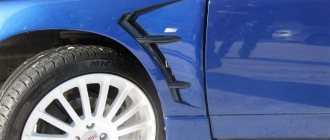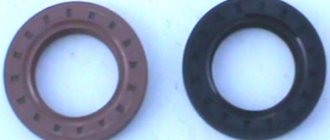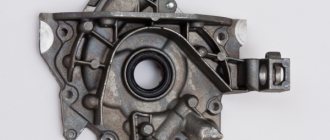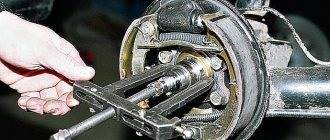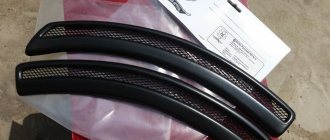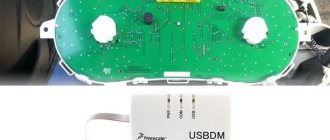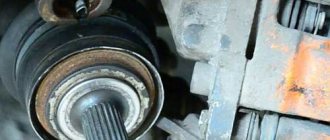The roof of a car usually remains in its original form longer than other body parts. This is explained by the fact that it is least intensively exposed to environmental factors, with the exception of atmospheric ones, however, they can also damage the paintwork over time. In addition, it becomes necessary to paint the roof of the car if it is repainted. This article discusses painting a car roof.
Preparatory work
First of all, you need to choose the paint color. You need to be especially responsible when choosing when repainting your car locally. To do this, you can use the code of the original paint, but you need to take into account that over the course of the vehicle’s operation, the paintwork may change shade. Therefore, sometimes it is advisable to use the help of a colorist. The situation with choosing the color of the paint material is simpler if the car is completely repainted.
Painting a car roof is not as difficult as it seems, and it begins with preparing the working surface. First, it is cleaned of all contaminants. If there are dents on the roof, they need to be straightened by straightening and leveled with putty. To understand the technology for carrying out this work, you should watch the video.
Before starting work, you need to cover all non-paintable elements of the car with plastic film, securing it with masking tape.
Then matting begins; for these works, you can use fine-grained sandpaper (P1000-P1200) or Scotch-Brite with matting abrasive paste. During the matting process, varnish or gloss is removed to ensure better adhesion of the new paint to the original. Upon completion of the work, the surface must be blown with a spray gun compressor in order to remove the resulting dust. You can clearly see the matting process in the video. Then the car roof is degreased with a cloth soaked in a solvent.
The final stage of preparatory work is wiping the work surface with a sticky cloth to completely clean it.
The use of masking, covering material and masking tape
In the room where the car is masked before painting, there must be a normal positive temperature (from +10 to +30 degrees Celsius). If the temperature in the workshop is low, the masking tape may adhere poorly or not at all to surfaces. Condensation on the machine will interfere with the adhesion of masking materials.
The principle of applying masking tape is very simple. One end of it is glued to the beginning of the border of the part adjacent to the body; with one hand, hold the roll of masking tape and unwind it, and with the other you control the accuracy of adhesion and press it to the surface.
The masking tape itself is a bit stretchy. When gluing a straight border, you do not need to stretch it much. As a result, the stretched edges may subsequently peel off when sprayed, and the paint will flow under them. You can and should stretch the tape when you are covering the boundaries of bends and corners. Thus, a not very wide camouflage tape (for example, 19 mm) goes well around the rather complex boundaries of various parts adjacent to the body. First, the edges of the unpainted part are covered with masking tape, then masking material is glued on top using additional tape.
To stick adjacent parts of different shapes to the very edge, you can use thin elastic masking tape (Fine Line Masking Tape). It is specially designed for easy framing of all kinds of curves. This is possible due to the high elasticity and small thickness of the tape. It is easy to stick it to the very edge of the part to be masked, and on top, without fear of “climbing” onto the edge, you can stick regular masking tape. This tape is also used for camouflage when drawing various inserts and stripes of a different color on the body. It makes masking easier, but also increases the cost of the process.
When masking, it is necessary that the covering material fits tightly to the car and does not dangle under the influence of compressed air from the spray gun. To do this, you don’t need to waste masking tape and glue every segment that can get on the freshly painted surface. Each edge should be secured with adhesive tape.
When covering the wheel arches along with the wheels from paint, you need to start by gluing half of the wide masking tape to the back side of the edge of the arch. A lot of dirt usually accumulates there. During the preparatory wash of the car, you must remember to thoroughly wash the inside of the wheel arches. After gluing half of the wide tape to the inside edge of the arch, the second half will freely protrude beyond the edge. You can stick masking paper or newspapers on it. This way, all the outer edges of the arch will be open and available for painting.
For a high-quality result, it would be a good idea to mask the internal parts of the hood and trunk lid. When painting, dust will get there and there may be traces of the car being repainted, which will be difficult to remove. The principle is that masking tape is glued to the edge of the back side of the hood and trunk lid, and masking paper is glued on top of it, again using masking tape.
It is very convenient to use polyethylene covering material to isolate unpainted areas. As mentioned above, it tends to stick to the surface of the car and can easily cover the entire part of the car that is not subject to painting during partial painting. In addition, you can cover the entire car with polyethylene covering material and then use a blade to cut out all the segments, which are immediately glued to the car with masking tape. You need to first cover all the edges of the parts that require masking with masking tape, then put the covering film on top and straighten it. Next, cut out and immediately glue the required segments, and remove the remaining film. Many craftsmen use this method of masking for painting. This requires some skill, but overall it is not difficult. Using a covering material to camouflage the entire vehicle has a number of advantages.
- Using a covering film speeds up the work. By cutting out the desired segment in place, you immediately glue it and the job is done. You don’t have to glue several segments (as is the case with newspapers and masking paper, if there is not enough space), you don’t wrap or glue unnecessary folds of the material.
- The amount of dust and dust during painting is reduced, since the film attracts dust.
- Less masking tape is wasted. For example, when covering with newspapers, an additional amount of masking tape is needed to stick several segments onto the glass.
- Repairs become cheaper. Covering film is not expensive and, as was written above, less masking tape is consumed.
Main works
Paint application should be carried out by uniform, smooth movement of the spray gun along the working surface. In this case, the movements should be fast enough so that the paint is not applied in a thick layer. You can paint from front to back or vice versa. Drying takes about 20 minutes, and a more precise time is indicated by the manufacturer on the packaging of the material.
Next, apply a second layer of paint; it should be thicker and thicker than the first, so the paint is diluted with less solvent. It is advisable to apply it from one of the edges of the roof to its center. Then, on the other side of the car, painting continues from the center to the opposite edge. The remaining gaps are painted perpendicular to the rear and front edges of the roof.
Usually the paint is applied in two layers, after which the car is left to dry. However, if you plan to coat it with varnish, it is advisable to complete this work on the same day, since the varnish does not adhere well to completely dry paint. The technology for applying varnish is the same; it is also applied in 2-3 layers. It is clearly demonstrated in many video lessons.
Once the paint has dried, you can buff it to provide protection and a completely smooth finish. Polishing technology can also be found in articles and videos by experienced users.
Wing repair
Some dents are easy to get rid of, so you can do it at home. So:
- First you need to squeeze out as much of the dent as possible. You need to choose the right tool. This gives the wing its overall geometric shape.
Note: you can use a small piece of spring and rest it on the floor. Place a wooden block under the dent and press firmly from below.
- Now you need to give the correct shape to the arch. To do this, take a hammer and lightly hit it from below with the flat side. In this case, the edge of the arch must be bent with pliers, since it can bend during impacts. This must be done carefully so as not to stretch the metal.
Left front fender for VAZ 2110
Note: if nothing works, you can take pliers, hook them on the lower side of the edge, and lightly hit it on the upper side.
- Using the sharp side of the hammer, you need to get rid of the edge that was formed as a result of the blows. This should be done from the top side.
- Now you need to rivet the edging outward. To do this you need to hit it with a hammer from below. At the same time, everything that sticks out around it should be moved into place.
- Now you need to rivet the wing with a sharp hammer on both sides.
Note: if a hammer does not fit everywhere, then you can take a narrow and at the same time long tool.
- If there are scratches, then they also need to be riveted out (this needs to be done either from the outside or from the inside).
Note: all machinations should be performed carefully, without making much effort, so that the wing geometry is as desired. The fact is that with strong impacts the iron will stretch, so the geometry of the wing may increase.
- When there are fewer defects left, you need to choose the largest defect and start riveting it out. And so continue until the defects practically change.
Wing repair
Note: defects can be determined by touch. To do this, you need to touch the whole part and the damaged one, trying to determine how they differ.
- When the defect is more or less corrected, you can begin painting.
Wing painting
Repair and painting of the VAZ 2110 wing
Before painting, it is necessary to straighten the wing if it has been damaged and has dents.
Note: if you only need to paint one specific part, you should block access to the other part. To do this, the gap between both parts must be sealed with paper tape.
You can use a rotary machine for painting. It has two positions: roter (sands out) and simple position (smoothes).
Painting is accompanied by the following actions:
- Putty. You need to stick on a thin adhesive tape, which will allow you to see how to putty. That is, with its help you can slightly highlight the edging. The defect should be filled in several layers (2-3). After this, you should remove the edging. Now you need to level the surface.
- Spread it with charcoal so you can see if there are any imperfections.
- Now you can apply the first coat of paint. And then another one.
- Lastly, wash the car to get rid of paint particles and polish the body.
How to remove rust from a fender
New wings for VAZ 2110
The fact is that many domestic cars “rot”, which is why rust appears. To get rid of it, you need to have 120th and 600th sandpaper (the amount of sandpaper depends on the size of the defect), putty, hardener, spatula (large and small), paint to match the color of the car, masking tape, degreaser, rags, rust remover (it may be different for everyone). So:
- First you need to get rid of the rust. You should grab a larger piece, even if it is not yet damaged, since the fungus has already spread to it.
- Now you need to degrease the surface.
- Cover the cleaning contour with masking tape so as not to catch any excess.
- Now you can start puttingty. Mix it with hardener and apply to the damaged surface of the car.
- When the putty is dry, you can remove the tape.
- Now you can start sanding with sandpaper.
- Actually, it's time for painting. Before doing this, you need to wipe the surface dry and lubricate the surface with a degreaser so that the paint sticks and does not fall off.
Note: it is better to paint horizontally rather than vertically, so that it is less noticeable. You can paint with a brush or spray can. Most likely, the paint will not cover the putty the first time, so you need to apply it in several layers.
By finding photos and videos on this topic on the Internet, you can quickly and easily deal with the problem of repairing, painting and replacing the wing. Any instructions provided can also be useful when repairing a car yourself. In this case, the cost of repairs will be minimal.
